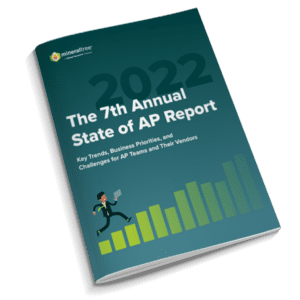One of the long-lasting legacies of the COVID pandemic is its impact on the workforce. According to a recent survey covered by CFO.com, 73% of respondents are having difficulty attracting employees, up from 56% in the first half of the year. Moreover, 70% of employers expect their hiring problems to persist into 2022.
The Accounts Payable department is among those acutely feeling the pain, as finance leaders struggle with a shortage of qualified candidates. While it’s not easy finding the right person to fill these essential positions, AP automation platforms can go a long way in alleviating the problem by handling the repetitive, routine tasks involved in invoice and payment processing, and doing them much faster and more accurately than humans can.
The irony is that while AP staff must have high-level skills, they often end up doing menial tasks. These employees must be knowledgeable about finance and best practices, and be trusted to handle sensitive financial data. They also need to be able to pay great attention to detail, while at the same time, work expeditiously to handle hundreds or thousands of invoices and payments every month. The discrepancy between their capabilities and job responsibilities not only makes these jobs hard to fill but can also lead to burnout and turnover.
Repetitive, manual AP tasks that are ripe for automation
Consider typical AP staff responsibilities:
Receive, process and route invoices.
In many companies, AP teams need to collect paper invoices received in different locations across the organization and manually enter the data into the accounting system. That’s a particularly grueling process at healthcare organizations, which may have lines and lines of supplies on invoices that need to be input. In addition, AP staff are responsible for coding the invoices, making sure that they match Purchase Orders, and then emailing—and chasing—department heads for the required approvals.The process of collecting and routing invoices has become even more challenging since the pandemic. In the wake of work-from-home mandates, AP staff had to go into the office to pick up invoices and send them to reviewers who were also working remotely. Not only does this make invoice processing more challenging, but it also adds time, which can result in late payments and penalties. These challenges aren’t expected to go away soon; in fact, all indications are that remote work is here to stay. According to our 2022 State of AP Report, 68.6% of finance teams are either remote or hybrid today, and that number is expected to reach 72.3% in the next 6 to 12 months. Regardless of whether an invoice is handled as paper or scanned, the AP staffer still needs to manually handle coding and matching, route it for approval, and chase down reviewers when they inevitably don’t respond.
By contrast, AP automation software handles all of these tasks automatically. The system automatically captures and codes invoice header and line-level data with a high degree of accuracy, matches invoices against issued POs, and then automatically routes to the appropriate reviewer(s) for approval. Because AP staff don’t need to handle these tedious tasks, invoices are processed more quickly and accurately, and employees are freed from spending most of their time on low-level tasks and can focus on higher-value activities.
Prepare and complete payments.
Under a manual AP process, once the invoices have been approved, AP staff have the laborious tasks of queuing up the payment batch, gathering supporting documentation, getting authorization from the CFO or controller to release payment, and then processing all payment types separately. When paying by check, remote AP staff have to go into the office to pick up check stock, print the checks, and get them to the CFO or controller for a signature (in some cases, via FedEx), and then stuff, stamp and mail each individual payment. But, the work for AP doesn’t stop after payment. AP clerks need to send payment notification and remittance to every supplier, report payments in the ERP and file invoices, reconcile individual statements, and compile AP data for analysis and action. AP teams can benefit from AP automation, since it takes care of all of these tasks efficiently and effectively and precludes the need for AP employees to go into the office or physically track down reviewers. As an added bonus, because these tasks are automated and include built-in security controls like two-factor authentication and segregation of duties, there is less chance of error or fraud.
Manage suppliers.
One of the most time-consuming tasks of the AP department is managing suppliers’ needs. At the onset of the relationship, AP staff have to call suppliers to determine their preferred payment method and then collect the appropriate payment details (e.g., bank information for ACH). AP staff need to make sure all this supplier information is continually up to date; record any requested changes to a supplier’s bank information, contact information, or address; and be on high alert to fraud at those times. If a supplier is getting paid by check, AP needs to make sure the check gets cashed, and if it has not been, contact the supplier to follow up. If the AP department uses positive pay to authorize check payments at the bank, it needs to manually manage that process as well, preparing and uploading the file to the bank.On top of these tasks, AP departments often spend countless hours – and get interrupted numerous times – fielding supplier inquiries about when they will receive payment and other routine questions.An AP automation partner that offers supplier enablement services can handle all these routine tasks for you, from onboarding suppliers, to managing payment details across all types (e.g., ACH, virtual cards, checks and even foreign exchange) to providing a dedicated team to respond to day-to-day supplier inquiries, typically more rapidly than AP departments that are juggling multiple activities. Some providers also offer a portal providing self-service options for suppliers to update payment details and check payment statuses.
Automation allows you to scale without adding hard-to-find AP resources
By offloading manual invoice, payment, and supplier management tasks from busy AP departments, AP automation relieves their burden, particularly at a time when qualified AP candidates are scarce. But given that automation is better suited for these tasks — and can do them faster, more accurately, and more securely — why wouldn’t you want to have them do it regardless of the availability of good candidates? In our 2022 State of AP Study, we found that 64% of companies that have implemented AP automation are processing more invoices and payments with the same size team, and another 13% have reallocated the staff time that they have freed up to other projects.
This approach will lead to happier, more productive AP employees who can manage the critical control points in the process, such as invoice exception management, payment authorization, as well as more strategic activities such as AP analysis. By automating AP, you will gain critical competitive advantage, maximizing your resources and enabling more secure, efficient, and effective operations to support a continuous supply of goods and services from suppliers.
Check out our 2022 State of AP Report today to learn more!




